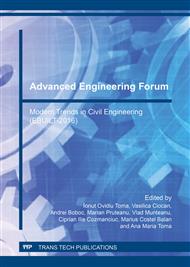p.196
p.207
p.213
p.219
p.226
p.234
p.242
p.249
p.255
Experimental Assessment Techniques for the Dynamic Properties of Concrete
Abstract:
Recent progress in measurement techniques have given rise to increasing interest in non-destructive testing. Incorporating non-conventional, recycled materials in concrete (i.e. rubber crumbs from discarded tires), the heterogeneity is increased. Based on this, it is of importance to determine to what degree the accepted protocols, valid for traditional materials, are applicable to newly developed construction materials with particular interest to rubberized concrete. Several tests, including parameters missing from the standardized measurement techniques, such as the increasing rate of the frequency during the sweep for finding the resonant frequency of the specimen, were conducted on two types of concrete: traditional and rubberized concrete. The assessment of the dynamic properties was done by means of the forced vibration method and the impact method. The obtained results indicate the fact that current procedures should be applied with care when considering aggregate replacement in traditional concrete by other recycled materials.
Info:
Periodical:
Pages:
226-233
Citation:
Online since:
March 2017
Price:
Сopyright:
© 2017 Trans Tech Publications Ltd. All Rights Reserved
Share:
Citation:


